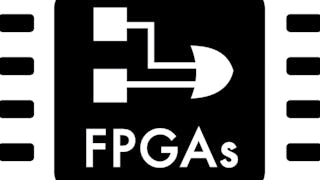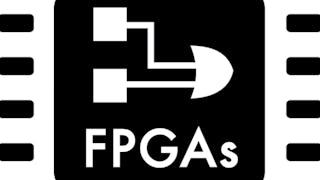This course can also be taken for academic credit as ECEA 5361, part of CU Boulder’s Master of Science in Electrical Engineering degree.



Hardware Description Languages for FPGA Design
This course is part of FPGA Design for Embedded Systems Specialization


Instructors: Timothy Scherr
43,600 already enrolled
Included with
(620 reviews)
What you'll learn
Explain the role of HDLs in design entry and verification for FPGAs and ASICs
Utilize HDL software tools for FPGA development
Skills you'll gain
Details to know

Add to your LinkedIn profile
1 quiz, 5 assignments
See how employees at top companies are mastering in-demand skills

Build your subject-matter expertise
- Learn new concepts from industry experts
- Gain a foundational understanding of a subject or tool
- Develop job-relevant skills with hands-on projects
- Earn a shareable career certificate

There are 4 modules in this course
This module introduces the basics of the VHDL language for logic design. It describes the use of VHDL as a design entry method for logic design in FPGAs and ASICs. To provide context, it shows where VHDL is used in the FPGA design flow. Then a simple example, a 4-bit comparator, is used as a first phrase in the language. VHDL rules and syntax are explained, along with statements, identifiers and keywords. Finally, use of simulation as a means of testing VHDL circuit designs is demonstrated using ModelSim, a simulator software tool. Programming assignments are used to develop skills and reinforce the concepts presented.
What's included
10 videos4 readings2 assignments4 programming assignments1 discussion prompt
In this module use of the VHDL language to perform logic design is explored further. Many examples of combinatorial and synchronous logic circuits are presented and explained, including flip-flops, counters, registers, memories, tri-state buffers and finite state machines. Methods of hierarchical design and modular design techniques are explained and demonstrated. How to create test benches is described as a means for design verification. Students are giving ample opportunity to practice and refined their design technique using the programming assignments.
What's included
10 videos2 readings1 assignment5 programming assignments
This module introduces the basics of the Verilog language for logic design. It describes the use of Verilog as a design entry method for logic design in FPGAs and ASICs, including the history of Verilog's development. Then a simple example, a 4-bit comparator, is used as a first phrase in the language. Verilog rules and syntax are explained, along with statements, operators and keywords. Finally, use of simulation as a means of testing Verilog circuit designs is demonstrated using ModelSim, a simulator tool. Programming assignments are used to develop skills and reinforce the concepts presented.
What's included
9 videos2 readings1 quiz1 assignment4 programming assignments
In this module use of the Verilog language to perform logic design is explored further. Many examples of combinatorial and synchronous logic circuits are presented and explained, including flip-flops, counters, registers, memories, tri-state buffers and finite state machines. Methods of hierarchical design and modular design techniques are explained and demonstrated. How to create test benches is described as a means for design verification. Students are giving ample opportunity to practice and refined their design technique by writing code as required by the programming assignments.
What's included
10 videos2 readings1 assignment5 programming assignments
Earn a career certificate
Add this credential to your LinkedIn profile, resume, or CV. Share it on social media and in your performance review.
Build toward a degree
This course is part of the following degree program(s) offered by University of Colorado Boulder. If you are admitted and enroll, your completed coursework may count toward your degree learning and your progress can transfer with you.¹
Instructors

Offered by
Explore more from Electrical Engineering
 Status: Free Trial
Status: Free TrialUniversity of Colorado Boulder
 Status: Free Trial
Status: Free TrialUniversity of Colorado Boulder
 Status: Preview
Status: PreviewUniversitat Autònoma de Barcelona
 Status: Free Trial
Status: Free Trial
Why people choose Coursera for their career




Learner reviews
620 reviews
- 5 stars
60.64%
- 4 stars
26.93%
- 3 stars
6.61%
- 2 stars
2.74%
- 1 star
3.06%
Showing 3 of 620
Reviewed on Aug 26, 2021
Excellent course! A broad review of several topics! Great videos and great assignments! I have been loving this specialization!
Reviewed on May 14, 2020
The Programming Assignments need to be more elaborate, things like reset is active low or active high and more details should be mentioned.
Reviewed on May 6, 2020
FIFO assignments in both Verilog and VHDL should define purpose of all the internal nets and registers listed in the problem.

Open new doors with Coursera Plus
Unlimited access to 10,000+ world-class courses, hands-on projects, and job-ready certificate programs - all included in your subscription
Advance your career with an online degree
Earn a degree from world-class universities - 100% online
Join over 3,400 global companies that choose Coursera for Business
Upskill your employees to excel in the digital economy
Frequently asked questions
To access the course materials, assignments and to earn a Certificate, you will need to purchase the Certificate experience when you enroll in a course. You can try a Free Trial instead, or apply for Financial Aid. The course may offer 'Full Course, No Certificate' instead. This option lets you see all course materials, submit required assessments, and get a final grade. This also means that you will not be able to purchase a Certificate experience.
When you enroll in the course, you get access to all of the courses in the Specialization, and you earn a certificate when you complete the work. Your electronic Certificate will be added to your Accomplishments page - from there, you can print your Certificate or add it to your LinkedIn profile.
Yes. In select learning programs, you can apply for financial aid or a scholarship if you can’t afford the enrollment fee. If fin aid or scholarship is available for your learning program selection, you’ll find a link to apply on the description page.
More questions
Financial aid available,

